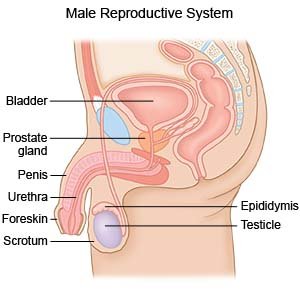Laser Prostatectomy
Medically reviewed by Drugs.com. Last updated on Sep 23, 2025.
Laser prostatectomy is surgery that uses a laser light beam to destroy part of the prostate gland. This can help reduce urinary problems caused by an enlarged prostate.
 |
WHILE YOU ARE HERE:
Before your surgery:
- Informed consent is a legal document that explains the tests, treatments, or procedures that you may need. Informed consent means you understand what will be done and can make decisions about what you want. You give your permission when you sign the consent form. You can have someone sign this form for you if you are not able to sign it. You have the right to understand your medical care in words you know. Before you sign the consent form, understand the risks and benefits of what will be done. Make sure all your questions are answered.
- An IV is a small tube placed in your vein that is used to give you medicine or liquids.
- Anesthesia is medicine to make you comfortable during the surgery. Healthcare providers will work with you to decide which anesthesia is best for you.
- General anesthesia will keep you asleep and free from pain during surgery. Anesthesia may be given through your IV. You may instead breathe it in through a mask or a tube placed down your throat. The tube may cause you to have a sore throat when you wake up.
- Spinal anesthesia is injected into the spine to numb you below the waist. You will remain awake during the surgery.
During your surgery:
- Your surgeon will insert a scope into your penis through your urethra. He or she will use the scope to find the narrowed part of your urethra that the prostate blocks. He or she will make an incision in the urethra to reach the prostate.
- Your surgeon will use a laser to destroy excess prostate tissue. He or she may remove a part of your prostate and pass it into your bladder. It will then be broken into tiny pieces. The pieces will be removed or left in your bladder to be passed out in your urine.
- Your surgeon may also use the laser to seal blood vessels and stop any bleeding. He or she will place a urinary catheter to help drain your urine.
Related medications
After your surgery:
You will be taken to a room to rest until you are fully awake. Healthcare providers will monitor you closely for any problems. Do not get out of bed until your healthcare provider says it is okay. When your healthcare provider sees that you are okay, you will be able to go home or be taken to your hospital room.
- You may need to walk around the same day of surgery or the day after. Movement will help prevent blood clots. You may also be given exercises to do in bed. Talk to healthcare providers before you get up the first time. They may need to help you stand up safely. When you are able to get up on your own, sit or lie down right away if you feel weak or dizzy. Then press the call button to let healthcare providers know you need help.
- You will be able to drink and eat gradually. You will begin with ice chips or clear liquids such as water, broth, juice, and clear soft drinks. If your stomach does not become upset, you may then eat soft foods, such as ice cream and applesauce. When you can eat soft foods easily, you may slowly begin to eat solid foods. Most people are able to eat normally the day after surgery.
- A Foley catheter is a tube put into your bladder to drain urine into a bag. Healthcare providers will remove the catheter as soon as possible to help prevent infection.
- Intake and output of the amount of liquids you are drinking and urinating may need to be tracked. Healthcare providers may need to strain your urine to check for stones. Do not flush your urine down the toilet unless healthcare providers say it is okay.
- Medicines:
- Pain medicine may be given. Do not wait until the pain is severe before you ask for more medicine.
- Antibiotics help prevent a bacterial infection.
- Antinausea medicine helps calm your stomach and prevents vomiting.
- Prostate medicine may be given to keep your prostate from growing larger. These may also help relax the muscles around your prostate and bladder so you may urinate more easily.
RISKS:
The laser may irritate or damage the tissue in and around your prostate. Nerves or blood vessels may be damaged, which may lead to problems urinating or having an erection. Your surgeon may need to make a larger incision than expected during surgery. Even with surgery, your prostate may become enlarged again and you may have problems urinating.
CARE AGREEMENT:
You have the right to help plan your care. Learn about your health condition and how it may be treated. Discuss treatment options with your healthcare providers to decide what care you want to receive. You always have the right to refuse treatment.© Copyright Merative 2025 Information is for End User's use only and may not be sold, redistributed or otherwise used for commercial purposes.
The above information is an educational aid only. It is not intended as medical advice for individual conditions or treatments. Talk to your doctor, nurse or pharmacist before following any medical regimen to see if it is safe and effective for you.
Further information
Always consult your healthcare provider to ensure the information displayed on this page applies to your personal circumstances.
